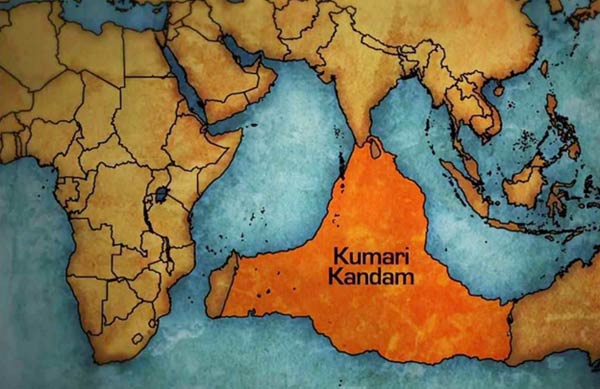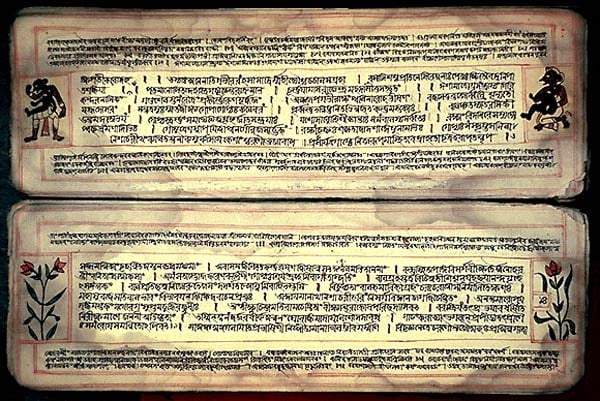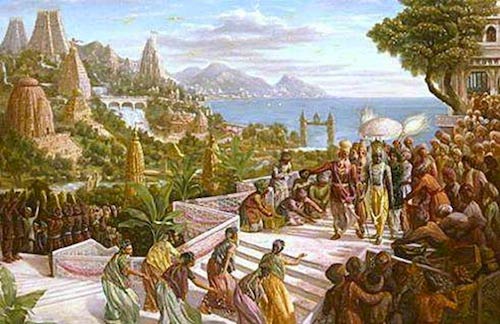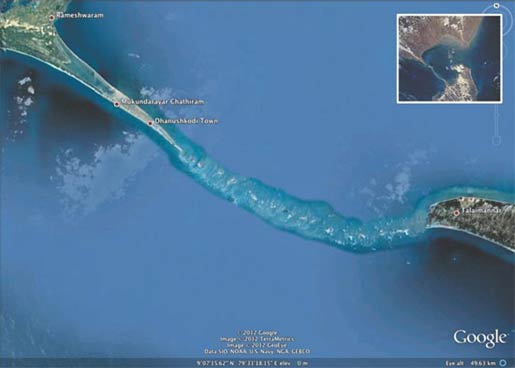The Lost Civilisation of Flooded India

The Lost Continent of Kumari Kandam
By Ḏḥwty
Most people are familiar with the story of Atlantis, the legendary sunken city as described by the ancient Greek philosopher Plato. Till this day, opinion is still divided as to whether this story should be understood literally or taken merely as a morality tale. Further east in the subcontinent of India is a similar tale, though it probably is less well known compared to that of Atlantis. This is the ‘lost continent’ of Lemuria, frequently connected to the legend of Kumari Kandam by speakers of the Tamil language.
The term Lemuria has its origins in the latter part of the 19th century. The English geologist Philip Sclater was puzzled by the presence of lemur fossils in Madagascar and India but not in mainland Africa and the Middle East. Thus, in his 1864 article entitled ‘The Mammals of Madagascar’, Sclater proposed that Madagascar and India were once part of a larger continent, and named this missing landmass ‘Lemuria’. Sclater’s theory was accepted by the scientific community of that period as the explanation of the way lemurs could have migrated from Madagascar to India or vice versa in ancient times. With the emergence of the modern concepts of continental drift and plate tectonics, however, Sclater’s proposition of a submerged continent was no longer tenable. Yet, the idea of a lost continent refused to die, and some still believe that Lemuria was an actual continent that existed in the past.
One such group is the Tamil nationalists. The term Kumari Kandam first appeared in the 15th century Kanda Puranam, the Tamil version of the Skanda Puranam. Yet, stories about an ancient land submerged by the Indian Ocean have been recorded in many earlier Tamil literary works. According to the stories, there was a portion of land that was once ruled by the Pandiyan kings and was swallowed by the sea. When narratives about Lemuria arrived in colonial India, the country was going through a period when folklore was beginning to permeate historic knowledge as facts. As a result, Lemuria was quickly equated with Kumari Kandam.

Bhagavata-Purana, 10th Skanda. Image source.
The story of Kumari Kandam is not regarded as just a story, but seems to be laden with nationalistic sentiments. It has been claimed that the Pandiyan kings of Kumari Kandam were the rulers of the whole Indian continent, and that Tamil civilisation is the oldest civilisation in the world. When Kumari Kandam was submerged, its people spread across the world and founded various civilisations, hence the claim that the lost continent was also the cradle of human civilisation.

An artist’s depiction of Kumari Kandam. Image source.
So, how much truth is there in the story of Kumari Kandam? According to researchers at India’s National Institute of Oceanography, the sea level was lower by 100 m about 14,500 years ago and by 60 m about 10,000 years ago. Hence, it is entirely possible that there was once a land bridge connecting the island of Sri Lanka to mainland India. As the rate of global warming increased between 12,000 and 10,000 years ago, the rising sea levels resulted in periodic flooding. This would have submerged prehistoric settlements that were located around the low-lying coastal areas of India and Sri Lanka. Stories of these catastrophic events may have been transmitted orally from one generation to another and finally written down as the story of Kumari Kandam.
One piece of evidence used to support the existence of Kumari Kandam is Adam’s Bridge (also called Rama’s Bridge), a chain of limestone shoals made up of sand, silt and small pebbles located in the Palk Strait extending 18 miles from mainland India to Sri Lanka. This strip of land was once believed to be a natural formation, however, others argue that images taken by a NASA satellite depict this land formation to be a long broken bridge under the ocean's surface.

The location of Adam's Bridge between India
and Sri Lanka
The existence of a bridge in this location is also supported by another ancient legend. The Ramayana tells the tale of Sita, Rama’s wife, being held captive on the island of Lanka. Rama commissions a massive building project to construct a bridge to transport his army of Vanara (ape men) across the ocean to Lanka.
As with most so-called myths, it seems likely that there is at least some truth to the ancient Tamil legends of Kumari Kandam, but just how much, is yet to be determined.
References
Jayakaran, S. C., 2011`. The Lemuria Myth. [Online]
Available at: http://www.frontline.in/navigation/?type=static&page=archiveSearch&aid=20110422280809000&ais=08&avol=28
Mahalingam, N., 2010. Lemuria and Kumari Kandam. [Online]
Available at: http://www.thehindu.com/news/national/tamil-nadu/lemuria-and-kumari-kandam/article482101.ece
Parameswaran, N., 2005. Tamil civilisation - is it the oldest?. [Online]
Available at: http://www.tamilguardian.com/article.asp?articleid=256
Wikipedia, 2014. Kumari Kandam. [Online]
Available at: http://en.wikipedia.org/wiki/Kumari_Kandam
Wikipedia, 2014. Lemuria (continent). [Online]
Available at: http://en.wikipedia.org/wiki/Lemuria_(continent)
-
See more at:
http://www.ancient-origins.net/myths-legends/lost-continent-kumari-kandam-001941#sthash.sD0UmacC.dpuf
From Ancient Origins @ http://www.ancient-origins.net/myths-legends/lost-continent-kumari-kandam-001941
Tamil civilisation - is it the
oldest?
By N.
Parameswaran
|
From the Tamil Guardian @ http://www.tamilguardian.com/article.asp?articleid=256
For more information about our flooded planet see http://nexusilluminati.blogspot.com/search/label/antediluvian%20world
- Scroll down through ‘Older Posts’ at the end of each section
Hope you like this
not for profit site -
It takes hours of work every day by
a genuinely incapacitated invalid to maintain, write, edit, research,
illustrate and publish this website from a tiny cabin in a remote forest
Like what we do? Please give anything
you can -
Contribute any amount and receive at
least one New Illuminati eBook!
(You can use a card
securely if you don’t use Paypal)
Please click below -
Spare Bitcoin
change?
Video - http://youtu.be/NjuSVHwNJMk
For further enlightening
information enter a word or phrase into the random synchronistic search box @
the top left of http://nexusilluminati.blogspot.com
And see
New Illuminati – http://nexusilluminati.blogspot.com
New Illuminati on Facebook - https://www.facebook.com/the.new.illuminati
New Illuminati Youtube Channel - http://www.youtube.com/user/newilluminati
New Illuminati on Google+ @ https://plus.google.com/115562482213600937809/posts
New Illuminati on Twitter @ www.twitter.com/new_illuminati
New Illuminations –Art(icles) by
R. Ayana @ http://newilluminations.blogspot.com
The Her(m)etic Hermit - http://hermetic.blog.com
DISGRUNTLED SITE ADMINS PLEASE NOTE –
We provide a live link to your original material on your site (and
links via social networking services) - which raises your ranking on search
engines and helps spread your info further! This site is published
under Creative Commons Fair Use Copyright (unless an individual article or
other item is declared otherwise by the copyright holder). Reproduction for non-profit use is permitted & encouraged,
- if you give attribution to the work & author. Please include a
(preferably active) link to the original (along with this or a similar notice).
Feel free to make non-commercial hard (printed) or software copies or
mirror sites - you never know how long something will stay glued to the web –
but remember attribution!
If you like what you see, please send a donation (no amount is too
small or too large) or leave a comment – and thanks for reading this far…
Live long and prosper! Together we can create the best of all possible
worlds…
From the New Illuminati – http://nexusilluminati.blogspot.com
I want to tell the worlds, that the illuminati is real because i have see the benefit of being a member of illuminati, i have tried to join the illuminati some many times, i have been scammed alot of money, but i did not give up because i know if i find the real illuminati, my life will be changed forever so i did not stop, on till i find the real illuminati official email and phone number, if you want to join the real illuminati, i want you to know that i can direct you to the really illuminati official email and phone number, brothers/sisters who is interested or who have be scammed so many times like me, that still have interest to join the illuminati because you believed that if you join your life will be changed, you do not have to worry about anything because i am here to show you all the right way to join the real illuminati, i want you all to know that to join the real illuminati it is free, you will not be ask to pay for any fee, all the process is free to join the illuminati, because when i joined the real illuminati i did not pay for any fee, when i was totally initiated to the illuminati, i was given so many benefits as a new member, i can tell you one of the benefits i was give an instant $2,000,000.00 to start a new life, brothers/sisters that have interest to join the illuminati, this is the real illuminati official email: churchofsataninitiationtemple@gmail.com the illuminati official email or WhatsApp number of how to join, if is free to join the illuminati.
ReplyDelete
ReplyDeleteIt was incredibly easy to find my way around and thanks for sharing this valuable stuff.
advanced java online training